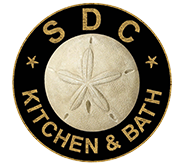Dear Fellow Design Buffs,
This month, let’s explore a cornerstone of kitchen and bath design: choosing the right countertops for your lifestyle. Countertops are more than just a work surface—they’re a major aesthetic and functional feature of your home. Whether you’re aiming for an elegant, understated look or a bold showpiece, your choice should reflect your design goals and how you live in your space.
Choosing the right material to fit your lifestyle, maintenance preferences, and budget is essential. Although countertops can sometimes be an afterthought, considering them from the start gives your project a huge advantage.
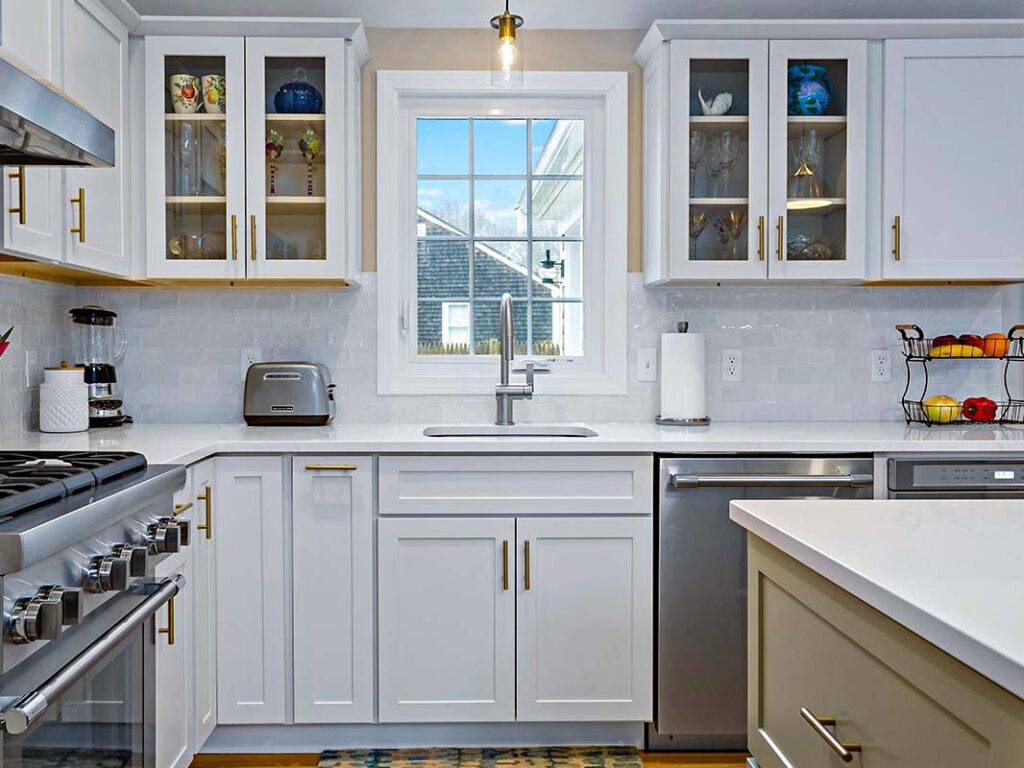
1. Understanding Your Needs
Let’s begin with how you use your space. How busy is your household? Do you love entertaining? Is your family a bustling crew of six (parents, kids, cats, dogs)? How often are you cooking, cleaning, and making use of the countertops?
It’s crucial to list your wants vs. needs—almost like a pros and cons list. Do you prioritize durability over elegance? Natural beauty over manufactured precision? Most people want materials that are low-maintenance and built to last.
Key factors to consider:
- Durability
- Heat resistance
- Stain resistance
- Ease of cleaning
Now let’s explore what’s available on the market.

2. Popular Countertop Materials and Their Features
- Quartz: Durable, non-porous, and low maintenance. Great for busy families and cooks.
- Granite: Natural beauty with unique patterns. Durable but requires periodic sealing.
- Marble: Timeless and luxurious, but delicate, prone to stains and scratches.
- Laminate: Budget-friendly and versatile, but less durable over the long term.
- Butcher Block: Warm, natural charm—great for rustic kitchens—but needs regular oiling and sealing.
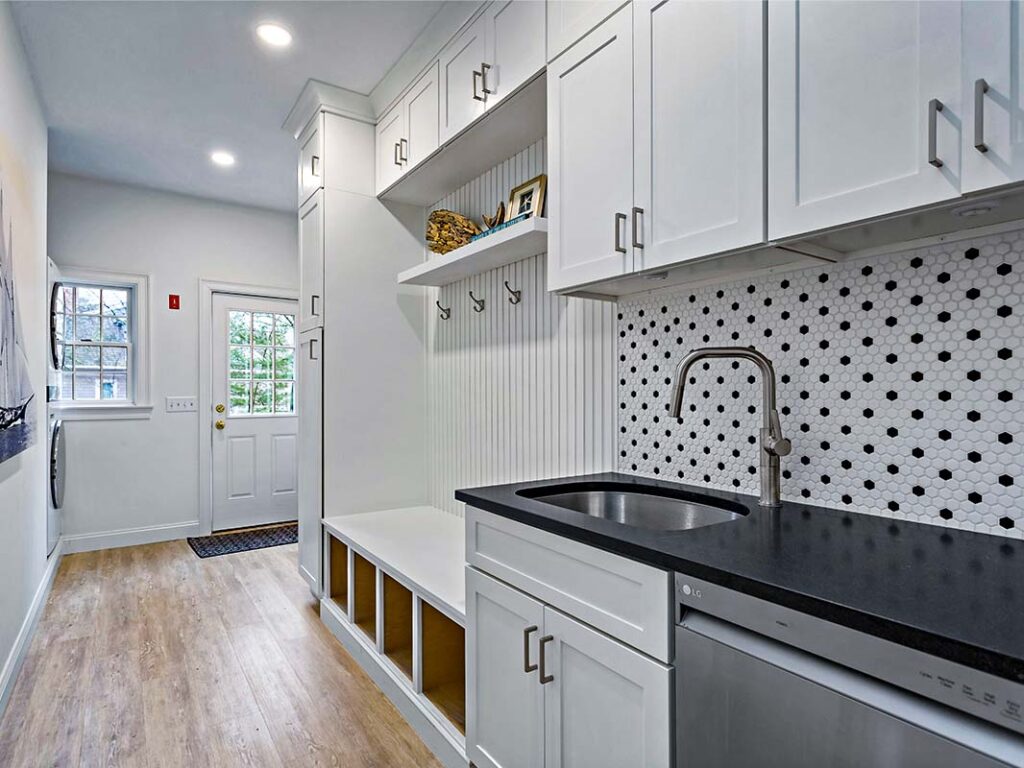
3. Balancing Aesthetics and Practicality
With materials in mind, let’s circle back to a key design principle: Color Theory and Lighting. Achieving aesthetic success starts with understanding how light interacts with your space. Here are a few essential questions to guide you:
- Does your room benefit from ample natural light, or will artificial lighting set the tone?
- Are your foundational colors leaning warmer (reds, yellows) or cooler (blues, grays)?
- How will your countertop choice harmonize with cabinetry, flooring, and fixtures?
It’s also important to consider the luminescence scale (light to dark). A countertop that dazzles in a showroom may look entirely different in your home’s unique environment, especially under varying light levels or with daily wear. Always test samples in your actual space and lighting—this step can make or break your design’s cohesion.
Once your design vision feels solid, pause to assess practicality and longevity. Will these materials and colors hold up beautifully over time? Beyond daily durability, also think about resale value: Certain materials and timeless styles add lasting market appeal, while trendier choices may feel dated sooner.
This is where an experienced designer’s expertise becomes invaluable. A skilled designer can:
- Balance style with functionality for a cohesive result
- Simplify overwhelming material and color decisions
- Steer you away from common pitfalls (like choosing a porous material for a busy kitchen)
- Tailor your design to your home’s architecture, lighting, and lifestyle
Plus, designers often have access to trusted suppliers and exclusive materials, helping unlock options you might not find elsewhere. Their expertise ensures your investment pays off, both in visual impact and long-term performance. In short, they transform good ideas into great outcomes, saving you time, stress, and costly mistakes.
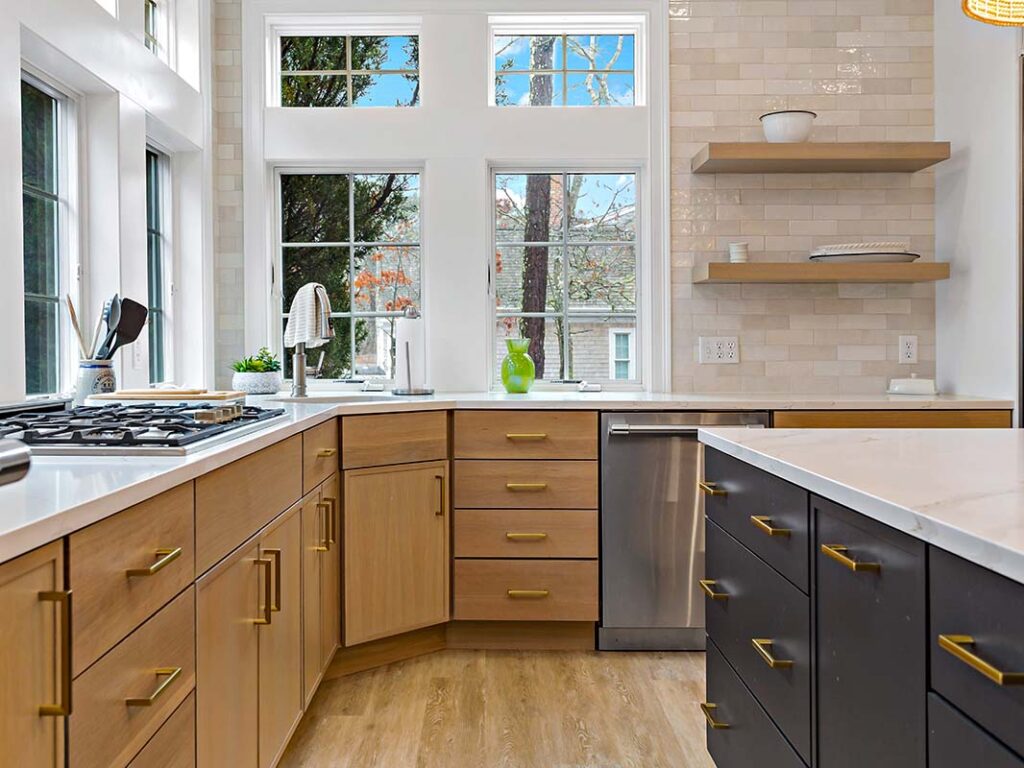
4. Maintenance and Longevity
Keeping your countertops beautiful and long-lasting is all about consistent care and using the right products. Here’s a deeper dive into what each material needs to stay in top shape, plus sealing recommendations for natural stones and wood:
Quartz:
- Cleaning: Use a mild dish soap and warm water for daily cleaning. For tougher grime, a gentle glass cleaner or a mix of water and isopropyl alcohol (70%) works well. Avoid harsh chemicals like bleach or oven cleaners, and don’t use abrasive scrubbers.
- Sealing: None required. Quartz is non-porous and incredibly low-maintenance.
Granite:
- Cleaning: Use a pH-balanced stone cleaner or a mix of mild dish soap and water. Avoid acidic or abrasive cleaners (like vinegar, lemon, or ammonia-based products), which can degrade the sealant over time.
- Sealing: Needs sealing every 1–2 years (sometimes more frequently in high-use areas). To check if resealing is needed, splash water on the surface—if it darkens quickly, it’s time to reseal.
Marble:
- Cleaning: Stick with pH-neutral stone cleaners or use warm water with a tiny bit of gentle dish soap. Always blot spills immediately—especially acidic ones (like wine, citrus, vinegar), which can cause etching. Never use abrasive pads or acidic cleaners.
- Sealing: Should be sealed every 6–12 months. Marble is more porous than granite, so keeping up with sealing is critical to protect against stains and etching.
Laminate:
- Cleaning: A soft cloth with mild dish soap and warm water works for daily upkeep. For stubborn spots, a baking soda paste (very gently applied) can be effective but avoid flooding seams and edges with water. Never use abrasive cleaners or steel wool, as they can scratch the surface.
- Sealing: None required. Laminate is non-porous and easy to maintain.
Butcher Block:
- Cleaning: Use mild dish soap and warm water, wiping with the grain. Disinfect with a mixture of white vinegar and water. For stains or odors, sprinkle baking soda and scrub gently with a sponge. Avoid soaking the wood or using harsh chemicals.
- Sealing: Needs monthly oiling with food-safe mineral oil or butcher block conditioner to prevent drying and cracking. Every 6 months, consider reapplying a beeswax finish or similar wood sealant for deeper protection.
Pro tip: For natural stone (granite, marble) and butcher block, keeping up with sealing doesn’t just maintain looks—it prevents long-term damage like staining, cracking, or warping. Always follow product labels carefully, and test new cleaners in a small, hidden spot before using them widely.
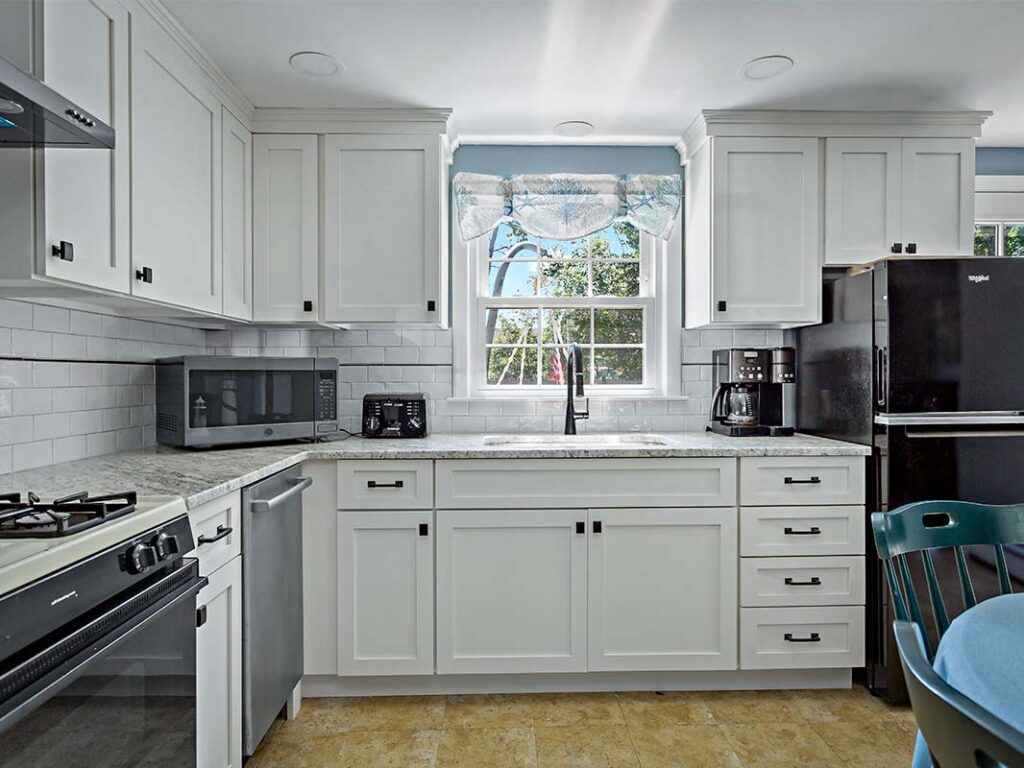
5. Budget Considerations
Let’s be honest: one of the first questions in any project is “What’s this going to cost me?” Countertops can range widely in price depending on material, size, and customization, so having a solid understanding of your budget early on is crucial.
Here’s a quick breakdown of average price ranges (per square foot, including installation) to guide your planning:
- Quartz: $70–$120 per sq. ft.
- Granite: $50–$100 per sq. ft.
- Marble: $80–$150 per sq. ft.
- Laminate: $25–$50 per sq. ft.
- Butcher Block: $40–$100 per sq. ft.
These ranges reflect average materials and standard finishes—exotic stones, thicker slabs, or complex edge profiles (like ogee or waterfall) can push costs higher.
Maximizing Your Investment:
- Remnants for Small Spaces: If you’re updating a vanity top, laundry room, or bar area, ask about remnant pieces. These are leftover slabs from larger jobs and are often deeply discounted.
- Mix & Match: To balance budget and style, consider mixing materials. For instance, you might pair a quartz island (high durability) with butcher block perimeters (warmth and cost savings).
- Customization Costs: Add-ons like integrated sinks, custom inlays, or full-height backsplashes will increase your overall investment, but they can make a huge design impact.
- Installation Matters: Always work with qualified installers—a great material is only as good as the craftsmanship behind it. Poor installation can lead to seams, cracks, and problems that cost more to fix later.
Long-Term Value:
Remember, your countertops are not just an upfront cost—they’re a long-term investment. Durable, timeless materials can enhance your home’s resale value and reduce maintenance or replacement costs down the road.
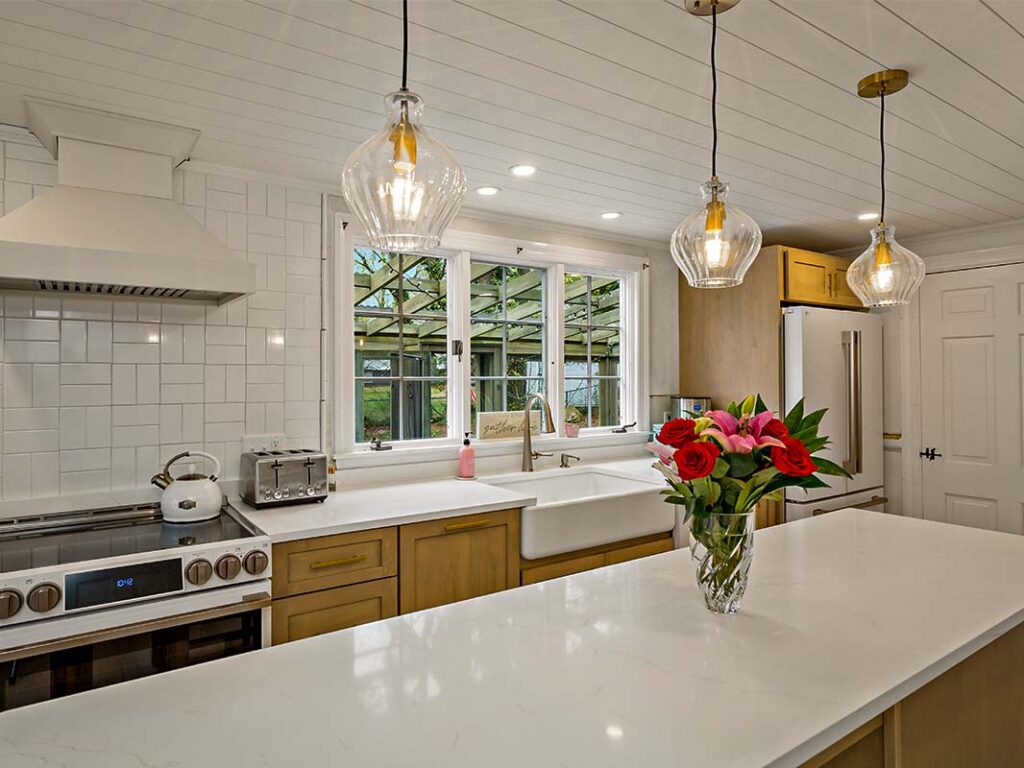
6. Trending Features and Customizations
Today’s countertops are as much about style as they are about function. Here are a few standout trends we’re seeing:
- Waterfall Edges: A seamless extension of the countertop down the sides for a bold, modern look.
- Integrated Sinks: Clean, minimalist design with sinks built directly into the countertop.
- Mixed Materials: Combining surfaces like quartz and butcher block for contrast and texture.
- Bold Veining & Book matching: Dramatic natural stone patterns that create a stunning visual impact.
- Matte & Honed Finishes: A softer, more understated alternative to high-gloss.
- Custom Inlays & Details: Unique accents like metal inlays or special edge profiles to personalize your space.
Countertop trends today are all about tailoring your space to fit both your style and practical needs, making your counters a true centerpiece.
Conclusion
Countertops are a significant investment, and the right choice blends form with function. Whether you crave a showstopper or a workhorse (or both!), careful planning and expert advice make all the difference. At Sand Dollar Customs, we’re here to help you navigate every step of the process—from inspiration to installation.
